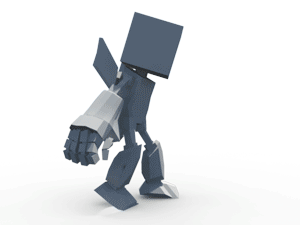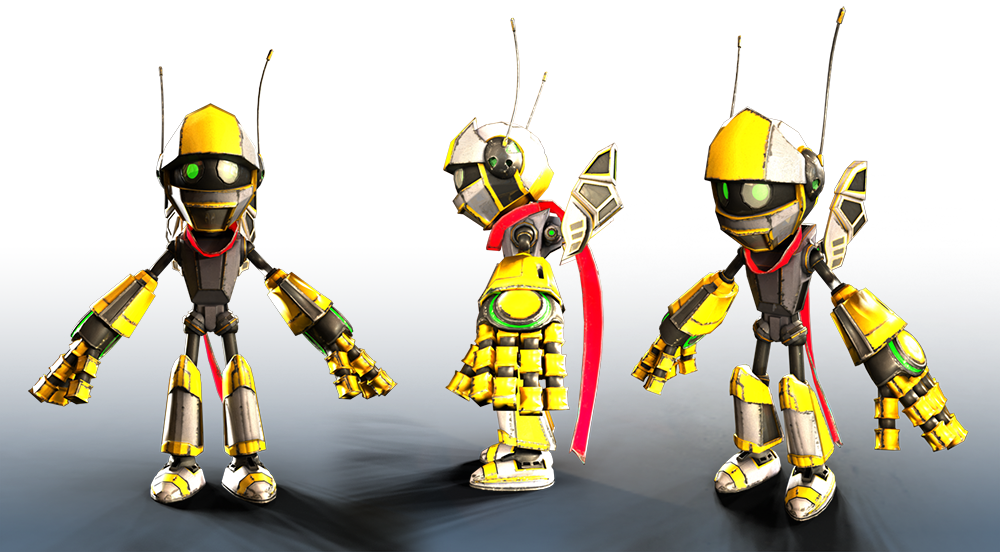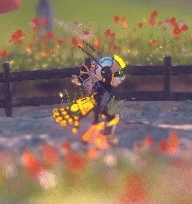Good to see you! Welcome to more Super Massive Awesome Robot. This week we shall be taking a look at the thought process that went into our prototype character.
At the beginning of the project we had a rough idea of the goals we wanted to achieve with the game. These goals included things like ‘fast, skill based platformer’, ‘robots’ and ‘awesome’. With these in mind, we formed up a long list of basic world assumptions, things like:
- Initial world unit sizes
- Character height in world units
- Jump heights
- etc.
These assumptions were dependent on whatever the main character (MC) ended up being and doing, but this gave us a starting point.
As the list of assumptions grew, it became obvious that getting a feel for the character was central for the direction of the project. So to start, we began playing with character ideas. We knew it would be a robot of some kind, so we began to play with basic shapes. Below is the initial rough prototype.
 Basic primitives let us experiment without getting too attached or precious
Basic primitives let us experiment without getting too attached or precious
You can see here that our first take was about 3 to 4 ‘heads’ tall. This came from taking inspiration from a lot of classic 8 and 16 bit type games. By contrast, an average adult human is between 6 to 7 heads tall. By reducing ‘head height’ you generally end up with proportions that are close to that of a child, or you push through to more of a stylised look (e.g. Micky Mouse is 3 heads tall; Captain America is 8-9 heads tall; the Hulk is often 14 heads tall).
Traditionally platformers have had small on-screen characters to allow for any action to be framed correctly. Thus proportions and silhouette of the prototype MC are incredibly important. This leads directly into how readable the character is on screen even during hectic action. A good character should be instantly recognisable by silhouette alone.
 Have a bonus donut for naming them all, go on, you are worth it!
Have a bonus donut for naming them all, go on, you are worth it!
Animation (and by extension how a character holds themselves) goes a long way to improving the readability of a silhouette, but the stronger the base shape is, the further the animation can push things.
There are some great examples of silhouette, readability and character development in the classics ‘How to Draw Comics the Marvel Way’ and ‘The Animators Survival Kit’.
You can see that we have emphasised the prototype MC’s hands. Personally, I consider the hands to be the most expressive part of a human, more so than even the eyes, so expanding on this trait to build character was important. Additionally this helps keep the hands readable even through the character is quite small on screen (which proved to be most unexpectedly helpful!).
Using this basic prototype model, we rigged and animated a pass of the basic animations (things like walks, runs, jumps, etc). This allowed us to quickly begin dropping the character into a simple game environment and begin to experiment with controls and movement. In total about one day was spend on the initial prototype model, including the first pass of animations.
The reason for quickly iterating through the character is that we want to give the world of SMAR a whole lot of personality. We could have prototyped game movement with a simple primitive, however having animation and movement considered early helps keep the idea of building personality at the forefront of decisions.

Additional iterations were carried out over a week or so. Some elements were kept, others thrown away. A bit of a side note, we generally approach prototypes as incredibly disposable experiments – you learn, you move on. It allows you to become attached to what is actually good, and not just become precious of the first idea (something we have seen way too much of in game development).
The final prototype iteration of the MC kept a number of bits we liked from the original and we changed others. For instance, in the final version we added a focus on the hands, adding elements that would allow the MC to use them for dashing, jumping and shooting. We also added a number of elements to allow for secondary animation (scarf, antenna, etc).
We will look at animation at another point, but the antenna and scarf were added for the simulation of secondary animation. Animation will move the character, but the simulations will help each moment feel unique and less like a ‘canned’ motion, which in turn adds more life to the MC.
 The proto-bot doesn’t have a name. Maybe Tim? These images are quick and dirty renders from the DCC.
The proto-bot doesn’t have a name. Maybe Tim? These images are quick and dirty renders from the DCC.
One of the areas we are playing around with is multiplayer – allowing players to face off against each other seemed like too good an opportunity to miss out on! With this in mind we chose to give the MC bold areas of colour. These areas can be swapped out with minimal fuss (allowing for players to have different colour schemes, helping clarify the action in multiplayer matches).
After a few iterations of rigs with the original prototype, we had a rig we quite liked. A rig usually consists of a skeleton and controls that hold the animation data. Having a standardised rig across the project allowed us to easily drop the test animations onto the final MC model.

Question, comments, queries, thoughts, musings? Drop us a line and I’ll do my best to work any answers into an upcoming ramble! Next up we shall take a look at movement.
Manly – hugs!
A.
